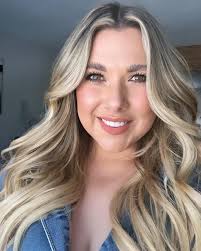Extensions for Thick & Coarse Hair: Your Guide to Seamless Length Without the Bulk
Have you ever looked in the mirror and thought, "I love my thick hair, but I wish it were longer," only to be followed by the worry, "But won't extensions just make it feel even bigger and heavier?"
Last month, my client Sarah sat in my chair and said exactly this. She has incredibly thick, coarse hair that falls just past her shoulders. She said, "I want long hair so badly, but I'm scared extensions will make my head feel like a bowling ball. My hair is already so heavy."
I get it. It's a common concern I hear all the time. The fear is that adding extensions to an already abundant head of hair will result in a bulky, unnatural look that's uncomfortable to wear.
Let me clear this up right now: thick and coarse hair isn't a challenge for extensions. It's the perfect canvas. With the right method and an expert application, your thick hair is actually a huge advantage, allowing for a secure, seamless, and stunning transformation.
It's all about working with your hair's natural strengths to add the length you crave, not unnecessary volume.
The Thick Hair Advantage: Why Your Hair is an Ideal Foundation
Instead of seeing your hair as "too much," let's reframe the conversation. Abundant hair provides two key benefits that make it incredible for extensions.
First, a strong, secure base. More hair means more anchor points. This gives a certified stylist a solid foundation to attach extensions, ensuring they stay put and feel secure.
Sarah was skeptical when I explained this. She said, "But won't more hair plus extensions equal too much hair?"
I said, "Sarah, your thick hair is actually going to help the extensions stay in better than someone with fine hair. And we're not adding volume, we're adding length."
Second, natural concealment. Your hair's density is your best friend when it comes to hiding attachments. Wefts, bonds, and tapes disappear easily within your natural volume, creating a truly undetectable look.
When I finished Sarah's install, she ran her fingers through her hair looking for the attachments. She said, "I can't feel anything! Where are they?"
I said, "That's the point. Your thick hair is hiding them perfectly."
First Things First: Decoding Your Hair's Unique Makeup
Before choosing a method, I always assess a client's hair. For thick hair, I look at two distinct characteristics.
Density refers to the number of individual hair strands on your head. If you have a hard time seeing your scalp, you likely have high density.
Coarseness describes the diameter of each individual strand. Coarse hair feels thicker and more substantial between your fingers compared to a fine strand.
My client Jennifer came in and said, "Everyone says I have thick hair, but what does that actually mean?"
I had her feel a strand of her hair between her fingers, then feel a strand of my fine hair. I said, "See how yours feels thicker? That's coarse hair. And look at your scalp, you can barely see it. That's high density. You have both."
She said, "Oh! I never understood the difference."
You can have dense hair that's fine, or you can have coarse hair that's less dense. Most clients who describe their hair as thick have a combination of both. Understanding this distinction is crucial because it informs the entire application process, from the type of extension used to the sectioning pattern.
The Best Extension Methods for Thick and Coarse Hair
For clients with abundant hair, the goal is usually to add length gracefully without creating a helmet head effect. We need methods that are both strong enough to hold on and versatile enough to blend flawlessly.
K-tips (keratin bonds): For ultimate customization
K-tips are individual strands tipped with a keratin bond that is fused to your natural hair.
Sarah, the client from the beginning, has extremely thick hair. I recommended k-tips because they are applied strand by strand, which allows me to place them with incredible precision.
I can break up bulk, fill in specific areas, and create fluid, natural movement that mimics your own hair. The bonds are extremely secure, making them a reliable choice for holding onto stronger, coarser hair strands.
When I finished Sarah's k-tips, she kept moving her head side to side. She said, "They don't feel heavy at all. I thought my neck would hurt."
Machine wefts: For maximum length with fewer rows
A weft is a curtain of hair, and a machine weft is a durable, thicker version that can be cut to fit your head.
My client Amanda has thick, coarse hair and wanted to go from shoulder length to waist length. I used machine wefts because they provide significant impact, allowing me to add a lot of length with just a few rows.
This is ideal for managing volume, as it concentrates the application and leaves more of your natural hair free. This method is powerful for creating dramatic length transformations quickly and effectively.
Amanda's transformation took about three hours. When I turned her around to the mirror, she gasped. She said, "That's the length I've wanted my entire life."
Tape-ins: For a flat, seamless finish
Tape-in extensions consist of a thin weft of hair attached to an adhesive strip, which is then sandwiched around a thin section of your own hair.
My client Michelle has thick hair and wanted something she could take out and reinstall herself eventually. I recommended tape-ins because when applied by a skilled professional, they lay incredibly flat against the scalp.
For thick hair, the key is meticulous application. I take super clean, thin sections to ensure the adhesive gets a perfect grip and the panels remain completely invisible. This method is fantastic for adding length around the face and achieving a sleek finish.
Michelle came back two weeks later and said, "I keep checking for them in the mirror and I still can't see them."
The Art of Integration: How I Make Extensions Disappear
Choosing the right method is only half the battle. The real magic happens during installation. Working with thick hair requires specialized techniques to ensure a perfect blend and comfortable wear.
Smart sectioning is everything
You can't use the same sectioning pattern on every client. For thick hair, I often use angled sections or a brick-lay pattern.
Sarah asked me during her install, "Why are you sectioning my hair at an angle instead of straight across?"
I said, "Because this strategic placement helps distribute the weight evenly and prevents the extensions from sitting on top of each other, which can create bulk."
I also leave out enough of the natural hair on top and around the hairline to ensure clients can wear their hair up without any attachments showing.
The expert's touch: Strategic thinning for a flawless blend
Now, don't be alarmed by the word thinning. I'm not talking about removing your hair's overall volume.
In some cases, I might use texturizing shears to slightly soften a tiny amount of natural hair right where the extension will be attached. This is a micro-technique that helps the extension bond lay flatter and integrate seamlessly, preventing that shelf look where extensions sit on top of the natural hair.
My client Jennifer was nervous when I mentioned this. She said, "You're going to thin my hair? Won't that make it look worse?"
I said, "Jennifer, I'm removing about ten hairs in a few strategic spots to help the extension lay flat. You won't even notice it's gone, but you will notice how much better the extensions blend."
After I finished, she said, "Oh, I see. It does look more natural."
This is an advanced skill that should only be performed by a seasoned, certified stylist.
Balancing weight for all-day comfort
One of the biggest concerns for thick-haired clients is comfort. The thought of adding more weight to already heavy hair can be daunting.
Sarah wore her extensions for three days and texted me: "I keep forgetting they're in. They don't feel heavy at all!"
This is where expert placement comes in. By distributing the extensions thoughtfully across the head, I ensure that no single area is carrying too much weight. The result? Extensions that feel surprisingly light and become a true part of your own hair.
Living Beautifully: Caring for Your New Length
With thick hair, proper maintenance is key to keeping your extensions looking gorgeous.
Be thorough when drying. Make sure to lift each weft or row and dry the attachment points completely. Trapped moisture can lead to slippage or matting.
My client Amanda learned this the hard way. She came in for her maintenance appointment and one of her wefts had started to slip. I asked, "Amanda, are you drying the attachment points?"
She said, "I thought I was supposed to avoid them."
I said, "No, you need to make sure they're completely dry. Trapped moisture is causing this."
Brush in sections. Don't try to tackle all your hair at once. Work in sections from the bottom up, holding the base of the extensions to prevent tension on your scalp.
Use the right products. Your abundant hair and new extensions deserve quality care. I always recommend sulfate-free shampoos and hydrating conditioners that will nourish both your natural hair and your premium remy extensions.
Frequently Asked Questions About Extensions for Thick Hair
Will they actually feel heavy?
Not when they're installed correctly! Sarah was shocked by how light hers felt. She said, "I expected my neck to be sore. Instead, I forget they're even in."
An experienced stylist meticulously balances the weight distribution so the extensions feel secure and comfortable, not heavy or strained.
How do you keep them from looking bulky or creating a shelf?
It's a combination of smart method selection, strategic placement, and a masterful blending cut. I cut and layer the extensions to flow seamlessly into your natural hair, eliminating any harsh lines.
My client Jennifer came back for her first maintenance and said, "Three different people asked me if I got a haircut. No one realized I had extensions in. They just thought my hair looked really good."
Can I still wear my hair in a ponytail?
Absolutely. I place the extensions with your lifestyle in mind, keeping them far enough away from your hairline to allow for versatile styling, including high ponytails and updos.
Sarah wears her hair in a high ponytail for CrossFit. She texted me a gym selfie and said, "No one can see them!"
My hair is coarse and sometimes frizzy. Will the extensions match my texture?
Yes. We use 100% premium remy human hair, which can be styled just like your own. I help you choose a texture that blends beautifully and give you tips on styling both your hair and the extensions for a cohesive look.
Ready for the Hair of Your Dreams?
Having thick hair isn't a barrier to getting the long, flowing locks you've always wanted. It's a starting point for an incredible transformation.
Sarah sent me a photo last week from a wedding. Her hair was down, long and flowing, and she looked stunning. The message said, "Best decision I ever made. Thank you for convincing me to do it."
With the right expertise, your hair's natural volume becomes the ultimate asset for creating a look that is secure, comfortable, and flawlessly natural.
Ready to get started? Book a consultation to discuss your hair goals, or learn more at Christian Michael Hair Extensions.

Tiffany Loe
Owner & Master Stylist
Hair extension expert and salon owner with a passion for helping stylists succeed. Tiffany has been transforming hair and building confidence for over 15 years.




